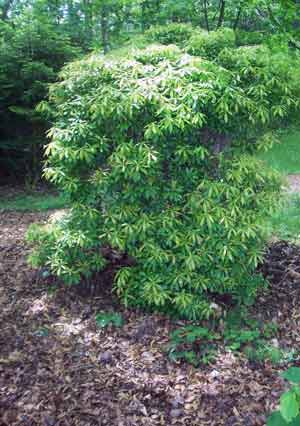Mulching: Hurt or help?After six years as a tree warden, Bill Marston of Old Saybrook, CT, registered a lot of concern for the future of urban trees. His simple statement is this: “It’s hard enough for trees to grow where there are lots of people and concrete.” He adds, “But some people work at making it hard for the trees.” One of his pet peeves is the practice of mounding mulch high around tree and shrub trunks, as much as 18” deep. Detractors refer to them as “mulch volcanoes.” Mulch can be a powerful ally in the battle for moisture retention or it can work for the enemy. The basic problem is this: More mulch is not always better. Too much mulch -- which is anything over 4” -- can exacerbate a drought by limiting water and air exchange in the soil. It can also lead to undesirable growth of tiny, hair-like roots—called adventitious roots--from the tree or shrub’s bark. Another drawback? Rodents love to burrow through soft mulch and munch the bark of young trees. If mulch volcanoes are bad, is the complete absence of mulch any better? “Grass is a very effective competitor for H2O,” says Sharon Douglas, PhD, plant pathologist with the Agricultural Experiment Station in New Haven. “It’s best to keep grass away from the plant base, especially with new plantings.” Grass is a very effective competitor for water. If you’ve ever given two dogs one bowl of water on a hot day, you understand the problem of grass growing over young tree roots on a hot day. The best practice is to apply no more than 4" of mulch and keep it at least 12" away from the trunk. Properly applied, mulch reduces moisture loss from soil by as much as 50% compared to unmulched areas. It reduces weeds, which are very thirsty competitors. As the mulch breaks down, it creates moisture-retaining organic matter in the soil. Here’s how to achieve “the mulch advantage” in your home landscape: Remove the grass in a circle between 12” – 48” wide, depending on the size of the planting and other features of the location. Leave a ring of bare ground about 2” – 6” around the plant. You may wish to put down a layer of finished compost about ½” thick to encourage organic matter. Then mulch the plant, never going higher than 2” - 4” of material. The depression around the trunk also funnels rainfall towards the roots. Use high quality mulch. The most familiar material is chipped or shredded bark or wood, which comes in a wide variety of types and chip sizes. Other quality mulches include shredded straw and salt marsh hay. Poor mulch – containing a lot of green material, for instance -- can actually rob the soil of nitrogen as it decomposes. Other examples of poor mulch would be ones suspect of chemical contamination, ones made from old treated lumber, mulch containing weed seeds, or material that is not well chipped. What about mulch from the dump? Most experts advise leaving it at the dump. There’s no telling which of the above problems it may contain. These days, mulch can be purchased in colors. Understand that these may be putting dyes into your soil that can have secondary effects. As always, purchase carefully. Read the bag. Shredded leaf mulch is both effective and free. Many people wonder, though, about oak leaves and pine needles. “When they’re fresh, oak leaves and pine needles are acid, “ says Carole Williamson, research specialist at the Home and Garden Education Center in the University of Connecticut’s Department of Plant Science. “It’s best to put them on acid-loving plants such as blueberries, hollies, azaleas and the like. The very best place for these mulches is beneath the oaks and pine that dropped the leaves.” Then she adds an important point. “Like all mulch materials, they eventually decompose to a nearly neutral pH. The compost of oak leaves and pine needles is fine for anything in the landscape.” Mulch has many wonderful effects on the landscape, not least of which is its ability to hold moisture in the soil. “Mulch is only as effective as the way it’s applied,” says Sharon Douglas of the Agricultural Experiment Station. |
Mulch should not be mounded around the tree base like a donut, shown below. Scroll down for best practices.
The "donut" shape permits water to drain towards the center and down. It also prevents the appearance of tiny, fibrous roots--called adventitious roots--that grow from the trunk when the lower bark is covered with mulch. Finally, keeping mulch away from the base of the trunk deters burrowing rodents. Rodents can gnaw the tender bark of young trees and kill it within one season.
Most trees and shrubs are happy with a simple layer of shredded leaves for mulch.
|




